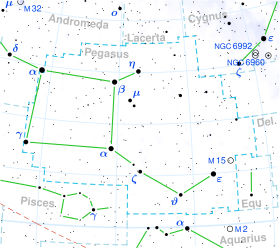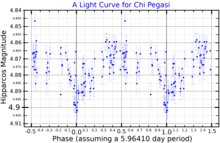Red giant star in the constellation Pegasus
Chi Pegasi
Observation dataEpoch J2000 Equinox J2000
Constellation
Pegasus
Right ascension
00 14 36.16451
Declination
20° 12′ 24.1205″
Apparent magnitude (V)
4.80
Characteristics
Evolutionary stage
asymptotic giant branch
Spectral type
M2+III
U−B color index
+1.91
B−V color index
+1.57
Variable type
suspected
Astrometry Radial velocity (Rv )−46.26±0.57 km/s Proper motion (μ) RA: +90.76 mas /yr Dec.: +1.24 mas /yr Parallax (π)8.86 ± 0.22 mas Distance 368 ± 9 ly pc ) Absolute magnitude (MV )−0.47 Details Mass 1.06±0.11 M ☉ Radius 52.88+1.31R ☉ Luminosity 435±23 L ☉ Surface gravity (log g )0.80 cgs Temperature 3,842±49 K Metallicity 0.00 dex Rotational velocity (v sin i )6.0 km/s Age 7.70±2.01 Gyr Other designations χ Peg , 89 Pegasi , NSV 99, BD +19°27, FK5 1004, GC 270, HD 1013, HIP 1168, HR 45, SAO 91792 Database references SIMBAD data
Chi Pegasi , Latinised from χ Pegasi, is a single star in the northern constellation of Pegasus , along the eastern constellation border with Pisces . It has a reddish hue and is faintly visible to the naked eye with an apparent visual magnitude of 4.80. The distance to this star is approximately 368 light-years based on parallax , but it is drifting closer with a radial velocity of −46 km/s.
A light curve for Chi Pegasi, plotted from Hipparcos data This is an aging red giant star on the asymptotic giant branch with a stellar classification of M2+III. It is about 8 billion years old with a mass 6% greater than the Sun's . With the supply of hydrogen at its core exhausted, the star has cooled and expanded to 53 times the girth of the Sun . It is radiating around 435 times the luminosity of the Sun from its swollen photosphere at an effective temperature of 3,842 K .
Chi Pegasi is a suspected small-amplitude variable . Koen and Eyer examined the Hipparcos
References
^ Van Leeuwen, F. (2007). "Validation of the new Hipparcos reduction". Astronomy and Astrophysics . 474 (2): 653–664. arXiv :0708.1752 . Bibcode :2007A&A...474..653V . doi :10.1051/0004-6361:20078357 . S2CID 18759600 . Vizier catalog entry
^ Ducati, J. R. (2002). "VizieR Online Data Catalog: Catalogue of Stellar Photometry in Johnson's 11-color system". CDS/ADC Collection of Electronic Catalogues . 2237 . Bibcode :2002yCat.2237....0D .
^ Eggen, Olin J. (July 1992). "Asymptotic giant branch stars near the sun". Astronomical Journal . 104 (1): 275–313. Bibcode :1992AJ....104..275E . doi :10.1086/116239 .
^ Keenan, Philip C.; McNeil, Raymond C. (1989). "The Perkins catalog of revised MK types for the cooler stars". Astrophysical Journal Supplement Series . 71 : 245. Bibcode :1989ApJS...71..245K . doi :10.1086/191373 . S2CID 123149047 .
^ Percy, John R.; Wong, Nancy; Bohme, Dietmar; Curott, David R.; Dempsey, Frank; Fortier, George L.; Ganis, Matt; Parello, Stephanie; Landis, Howard J.; Luedeke, Kenneth D.; Pray, Donald; Smith, Michael S.; Snyder, Leroy F.; Thompson, Raymond R.; Wasson, Rick; Williams, Harold O.; Walker, William S. G.; Wood, James E. (June 1994). "Photometric Surveys of Suspected Small-Amplitude Red Variables. III. an AAVSO Photoelectric Photometry Survey" . Publications of the Astronomical Society of the Pacific . 106 : 611. Bibcode :1994PASP..106..611P . doi :10.1086/133420 .
^ Massarotti, Alessandro; et al. (January 2008). "Rotational and Radial Velocities for a Sample of 761 HIPPARCOS Giants and the Role of Binarity" . The Astronomical Journal . 135 (1): 209–231. Bibcode :2008AJ....135..209M . doi :10.1088/0004-6256/135/1/209 .
Anderson, E.; Francis, Ch. (2012). "XHIP: An extended hipparcos compilation". Astronomy Letters . 38 (5): 331. arXiv :1108.4971 . Bibcode :2012AstL...38..331A . doi :10.1134/S1063773712050015 . S2CID 119257644 . Vizier catalog entry
^ Baines, Ellyn K.; et al. (2018). "Fundamental Parameters of 87 Stars from the Navy Precision Optical Interferometer" . The Astronomical Journal . 155 (1). 30. arXiv :1712.08109 . Bibcode :2018AJ....155...30B . doi :10.3847/1538-3881/aa9d8b . S2CID 119427037 .
Brown, A. G. A. ; et al. (Gaia collaboration) (August 2018). "Gaia Data Release 2: Summary of the contents and survey properties" . Astronomy & Astrophysics 616 . A1. arXiv :1804.09365 . Bibcode :2018A&A...616A...1G . doi :10.1051/0004-6361/201833051 .Gaia DR2 record for this source at VizieR .
"chi Peg" . SIMBAD Centre de données astronomiques de Strasbourg . Retrieved January 12, 2011.Eggleton, P. P.; Tokovinin, A. A. (September 2008). "A catalogue of multiplicity among bright stellar systems" . Monthly Notices of the Royal Astronomical Society . 389 (2): 869–879. arXiv :0806.2878 . Bibcode :2008MNRAS.389..869E . doi :10.1111/j.1365-2966.2008.13596.x . S2CID 14878976 .
"Light Curve" . Hipparcos ESA . ESA. Retrieved 10 October 2022.Koen, Chris; Eyer, Laurent (March 2002). "New periodic variables from the Hipparcos epoch photometry" . Monthly Notices of the Royal Astronomical Society . 331 (1): 45–59. arXiv :astro-ph/0112194 . Bibcode :2002MNRAS.331...45K . doi :10.1046/j.1365-8711.2002.05150.x .
External links
Categories :
Text is available under the Creative Commons Attribution-ShareAlike License. Additional terms may apply.
**DISCLAIMER** We are not affiliated with Wikipedia, and Cloudflare.
The information presented on this site is for general informational purposes only and does not constitute medical advice.
You should always have a personal consultation with a healthcare professional before making changes to your diet, medication, or exercise routine.
AI helps with the correspondence in our chat.
We participate in an affiliate program. If you buy something through a link, we may earn a commission 💕
↑

